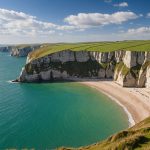Best Locations for Capturing the Coastal Cliffs
Exploring the best photography spots in Dorset is essential for capturing the awe-inspiring coastal cliffs of the region. These spots offer a diverse array of natural beauty, perfect for both amateur and professional photographers seeking to frame the region’s splendor.
Iconic Viewpoints
A must-visit along Dorset’s coastline is the celebrated Durdle Door. This natural limestone arch affords photographers dramatic views, especially when framed against a blazing sunset. Similarly, the cliffs near Lulworth Cove provide an accessible vantage point. Paths are well-marked, though a moderately challenging hike ensures you are rewarded with spectacular panoramas.
Additional reading : Exploring Sheffield’s Steel Roots: Premier Methods to Uncover Britain’s Industrial Heritage
Hidden Gems
For those willing to venture off the beaten path, Golden Cap, the highest cliff on England’s south coast, offers unique perspectives devoid of crowds. Striking vistas from Eype and Seatown encompass untouched landscapes, revealing the coast’s rugged charm. Seek out lesser-known spots to find secluded areas that enrich your photography with an intimate view of nature’s artistry.
Safety Considerations
When navigating these cliffs, especially when searching for remote vantage points, maintaining cliff safety awareness is crucial. Do respect local regulations to ensure both personal safety and environmental preservation, heeding signs and abiding by designated paths to prevent potentially hazardous situations.
Also read : Exploring Sheffield’s Steel Saga: Best Tips to Unveil the City’s Storied Industrial Past
Optimal Times for Photography at the Cliffs
Capturing the majestic beauty of Dorset coastal cliffs photography requires not only the right location but also perfect timing. Golden hour, which occurs just after sunrise and before sunset, casts a warm glow, enriching the textures and tones of the cliffs. This soft, diffused light highlights intricate cliff formations, making it an ideal time for dramatic shots. Similarly, the blue hour, immediately following sunset or preceding sunrise, offers a cooler light that can create a serene, mystical atmosphere over the seascape.
Understanding seasonal changes is crucial to optimizing Dorset’s photography opportunities. Each season alters the landscape’s appearance; for instance, spring’s vibrant growth enhances the lushness of the surroundings, while autumn adds warm earth tones to your images. Furthermore, weather conditions, like cloud formations or mist rolling off the sea, can add a dynamic element, enhancing the dramatic effect.
Photographers should monitor forecasts to catch unique weather phenomena that may occur. A gentle mist or looming storm clouds can transform an ordinary photo into something extraordinary. Thus, keeping track of light and seasons ensures you capture the cliffs at their most powerful, emphasizing their natural grandeur.
Introduction to the Coastal Cliffs of Dorset
The Dorset coastal cliffs present an unparalleled visual spectacle, attracting both photographers and adventurers. These cliffs aren’t just beautiful; they hold significant geological importance. Formed over millions of years, they reveal a time capsule of Earth’s history, displaying layers from the Jurassic period. This makes photographing the Dorset cliffs not only artistically rewarding but a fascinating exploration of nature’s timeline.
The visual allure of these cliffs stems from their dramatic formations—towering heights, jagged edges, and secluded coves. Such features make them a hotbed for photographic opportunities, offering diverse backdrops and endlessly new perspectives to explore. Capturing these landscapes requires understanding both their artistic and historical contexts.
This region’s cliffs aren’t merely scenic; they are a dynamic intersection of nature’s forces. Constantly shaped by wind and wave erosion, they underscore the power and beauty of nature. Every shot taken tells a story of transformation and endurance. For any photographer seeking to immortalize the coastal grandeur, Dorset offers a rich tapestry of stories woven into its rocks and vistas. Emphasizing these elements creates depth and meaning in each photograph captured.
Essential Gear for Photographing Coastal Cliffs
When venturing into the world of photography equipment for coastal landscapes, choosing the right gear is imperative to capture the rugged beauty of Dorset’s cliffs. A camera with a high-resolution sensor enhances the quality of your landscape photography, allowing for rich detail and vibrant colours. Pairing it with a wide-angle lens helps you encapsulate the vastness of the scene, delivering those breathtaking vistas.
Stability is key, and this makes tripods and stabilizers invaluable. Gusty coastal winds can easily compromise a shot, but a sturdy tripod ensures sharpness even in challenging conditions. Additionally, using a remote shutter release can minimise camera shake.
In the often harsh coastal environments, durable accessories like waterproof bags and lens filters are crucial. Filters, particularly polarising ones, can reduce glare and enhance contrast and colour saturation, perfect for the varying light conditions encountered.
Essential Accessories
- Waterproof gear: Protects equipment from spray and rain.
- Polarising filters: Cuts reflections and enriches tones.
Investing in these tools not only elevates your image quality but also your entire coastal photography experience by mitigating risks and enhancing creativity.
Techniques for Capturing Majestic Shots
Diving into the world of coastal cliff photography requires honing specific photography techniques for cliffs to truly capture their grandeur. One essential method is mastering composition, where the rule of thirds and symmetry add balance to your shots. Framing the jagged cliffs alongside the sweeping ocean amplifies their majestic scale.
Leading lines play a pivotal role in directing the viewer’s eye through your photograph. The natural lines found in cliff formations and shoreline can draw attention to the main subject, creating a sense of depth. Employ these lines to guide the observer’s gaze from foreground to background, immersing them in the landscape.
Exploring long exposure techniques can elevate your coastal imagery by softening water movements and accentuating the cliffs. By reducing shutter speed, the sea becomes a smooth blanket, contrasting the rugged terrain. This effect creates a surreal and dramatic atmosphere, ideal for capturing the dynamic interaction between land and sea.
Incorporating these techniques adds artistry and layers of interest to your coastal photography, turning each shot into a work of creativity and skill. With practice, photographers can capture images that not only portray the cliffs’ beauty but also narrate the story of this captivating landscape.
Showcasing Personal Experiences and Successful Shots
Embarking on a journey of Dorset coastal cliffs photography is an adventure packed with memorable experiences and breathtaking shots. One photographer recounted the unexpected serenity of Golden Cap. Arriving at dawn, the play of soft morning light over the cliffs made the early start worthwhile. Capturing a panoramic view with a wide-angle lens offered an immersive sense of the landscape.
Successful photographic examples often highlight the unique interplay between natural elements and the cliffs. A renowned photograph might focus on the contrast between the harsh rock face and the gentle ebb and flow of the sea below. Such images are testament to the photographer’s patience and timing, often waiting hours for the perfect shot.
Many enthusiasts also face challenges, like unpredictable weather altering conditions rapidly. To overcome these, being adaptable and prepared with essential gear like waterproof covers for cameras ensures resilience. Skills in handling fluctuating light settings or unexpected rain can transform potential obstacles into creative opportunities.
These personal anecdotes and examples inspire others to try their hand at capturing the splendour of Dorset’s cliffs, showcasing how passion and preparation can lead to remarkable imagery.
Local Attractions and Conservation Efforts
Exploring the majestic beauty of Dorset’s coast offers a chance to combine photography with a visit to nearby attractions that enhance your experience. The Jurassic Coast World Heritage Site holds a treasure trove of geological history, while the charming villages like West Bay and Lyme Regis provide quaint background settings for captivating shots. Natural wonders, like Chesil Beach, add another layer of interest to your photographic adventure.
When indulging in Dorset coastal cliffs photography, it’s crucial to prioritize conservation and responsible photography practices. The cliffs and surrounding environments are delicate, needing protection from the impact of human activity. Photographers should adhere to guidelines that prevent disturbances to wildlife and natural habitats, including staying on designated trails and avoiding causing erosion or damage.
For those wishing to contribute to the region’s preservation, local organizations offer opportunities for involvement. Groups like the Dorset Wildlife Trust actively work toward conservation efforts focused on sustaining the area’s ecological balance. Participating in their initiatives not only aids in conservation but can also provide deeper insights into the region’s natural beauty. Engaging with these efforts ensures that the stunning landscapes remain preserved for future generations.









